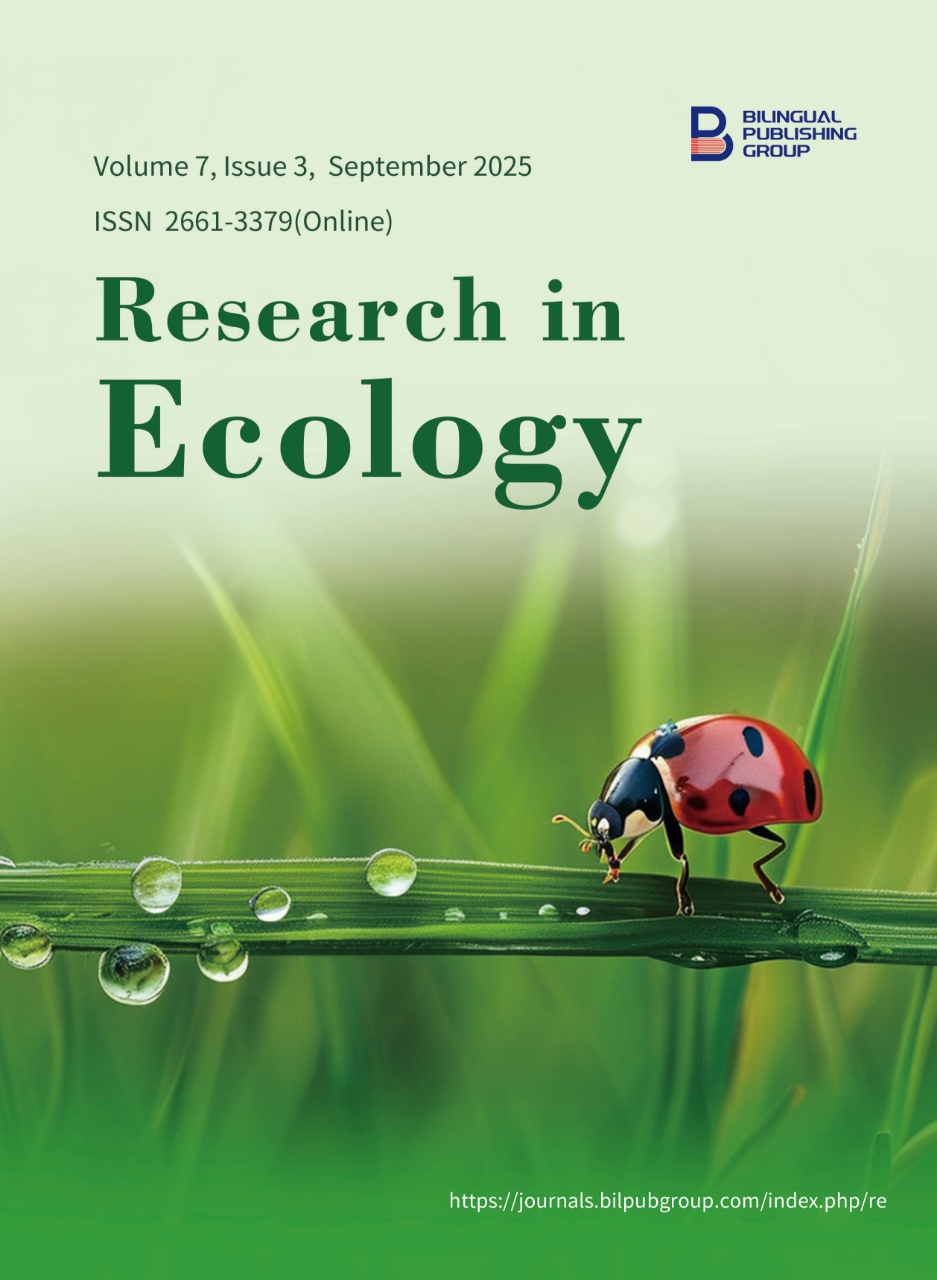
Ecological Enhancement of Agaricus bisporus L. Mushrooms' Vitamin Content Using Carbon Nanotubes, Magnetic Iron Nanoparticles, and Biostimulants
DOI:
https://doi.org/10.30564/re.v7i3.9797Abstract
The edible mushroom Agaricus bisporus L. plays a crucial ecological role in nutrient cycling and organic matter decomposition, alongside its increasing importance in the food and nutrition industry. This study explored ecological interventions to enhance the mushroom's vitamin content by enriching its cultivation substrate with nanomaterials and biostimulatory agents. The experiment was conducted within the mushroom production project at Al-Qadisiyah Governorate, Iraq. The compost-based medium was amended with magnetic iron nanoparticles (N-FeO), carbon nanotube (CNT) suspensions, EM biofertilizer, and Atonik growth stimulant. Their ecological impact on the enrichment of fat-soluble (A, D, E) and water-soluble (B2, B3, B5, B6) vitamins in mushrooms was assessed. The study employed a Completely Randomized Design (CRD) with three replicates. Results revealed that the synergistic application of these eco-friendly treatments significantly enhanced the vitamin profiles of A. bisporus. The highest concentrations of vitamins B2 and B5 (5.16 and 17.70 mg kg⁻¹, respectively) and vitamin A (6.87 IU ml⁻¹) were recorded under the combined quadruple treatment. Additionally, the triple treatment (N-FeO + EM + Atonik) notably increased levels of vitamins B2 (4.47 mg kg⁻¹), B6 (25.66 mg kg⁻¹), D (34.76 mg kg⁻¹), and vitamin A (6.87 IU ml⁻¹). Dual treatments (EM + Atonik) also significantly improved vitamin B2 (4.54 mg kg⁻¹) and vitamin E (3.30 mg kg⁻¹) contents. These findings demonstrate that integrating nanomaterials and biostimulants can serve as an ecological strategy to improve the nutritional quality of mushrooms while promoting sustainable agricultural practices.
Keywords:
Agaricus bisporus L.; Ecological Cultivation; EM Biofertilizer; Iron Nanoparticles; Carbon Nanotubes; Sustainable Agriculture; Water-Soluble Vitamins; Fat-Soluble VitaminsReferences
[1] Chang, S.T., Wasser, S.P., 2017. The cultivation and environmental impact of mushrooms. In Oxford research encyclopedia of environmental science.
[2] Sahib, R.S., Shafiq, S.A., Chechan, R.A., 2022. Optimal Conditions for the Production of Mother Culture for Cultivated Iraqi Edible Mushroom Lentinula edodes RSR strain (Shiitake Mushroom). Arab Journal of Plant Protection. 40(4), 356–361.
[3] Krishnan, R., Greeshma, G.M., Lawrence, B., et al., 2023. Insight of Bioresources from Lower Plant Groups: Reconciling the Possibilities and Responsibilities. In Conservation and Sustainable Utilization of Bioresources. pp. 59–77.
[4] Almjalawi, B.S.A., Chechan, R.A., Alhesnawi, A.S.M., 2024. Some Applications of Hericium erinaceus Mushrooms: A Review. South Asian Research Journal of Agriculture and Fisheries. 6(5), 92-100.
[5] Rees, W.E., 2023. The human ecology of overshoot: why a major ‘population correction is inevitable. World. 4(3), 509–527.
[6] Batool, S.A.A., Rukaibaa, A.C., Lamees, T.A., 2023. Food residues (potato peels) are used as an alternative to potato dextrose agar to grow edible food fungi. Journal of Applied and Natural Science.15(1), 211–219. DOI: https://doi.org/10.31018/jans.v15i1.3989
[7] Bell, V., Silva, C.R.P.G., Guina, J., et al., 2022. Mushrooms as future generation healthy foods. Frontiers in Nutrition. 9, 1050099.
[8] Farhan, E.M., Chechan, R.A., 2020. Evaluating the ability of Pleurotus ostreatus aqueous Extract to modulate genotoxicity induced by Cyclophosphamide in mice bone marrow cells. The Iraqi Journal of Agricultural Science. 51(5), 1405–1412.
[9] Farhan, E.M., Chechan, R.A., 2023. Production of Food Mushrooms (Lentinula edodes) Isolated from the Iraqi Environment Using Agricultural Waste. In IOP Conference Series: Earth and Environmental Science. 1158(11),112024.
[10] El-Ramady, H., Abdalla, N., Badgar, K., et al., 2022. Edible mushrooms for sustainable and healthy human food: nutritional and medicinal attributes. Sustainability, 14(9), 4941.
[11] Youness, R.A., Dawoud, A., ElTahtawy, O., et al., 2022. Fat-soluble vitamins: updated review of their role and orchestration in human nutrition throughout life cycle with sex differences. Nutrition & Metabolism. 19(1), 60.
[12] Mezaal, E.N., Mohammed, M.A., Sadiq, K.A., 2023. Determination of vitamin E concentration in different samples. Ibn AL-Haitham Journal For Pure and Applied Sciences. 36(3), 273–282.
[13] Al-juthery, H.W., Alkhlefawi, A.M., Al-Taey, D.K., et al. 2023. Innovative Soil, Water and Plant Management Promoting Sustainable Agriculture and Environments: A Review. In IOP Conference Series: Earth and Environmental Science .1259(1), 012014.
[14] Boddula, R., Singh, J., Jairam, T., 2024. Exploring the different anisotropic chirality-based carbon nanotubes and their organic/inorganic composites in rotten crop toxin sensing, prevention, and shelf-life expansion. In Carbon-Based Nanomaterials in Biosystems. 269-297.
[15] Sun, Z., Liu, S., Zhao, D., et al., 2023. Study on the motion of single particle chain in the magnetorheological fluid under the action of traveling magnetic field: smart Materials and Structures. 32(11), 115027.
[16] Francesca, S., Arena, C., Hay Mele, B., et al. 2020. Using a plant-based biostimulant improves plant performance and fruit quality in tomato plants grown at elevated temperatures. Agronomy. 10(3), 363.
[17] Hundi, H.K., Hamid, M., Noori, A., 2025. Role of Ochrobactrum Bacteria and Organic Matter in Plant Growth and the Content of N, P, and K Under Soil Salinity Stress. Journal of Environmental & Earth Sciences. 7(5), 130–139. DOI: https://doi.org/10.30564/jees.v7i5.8777
[18] Bulgari, R., Franzoni, G., Ferrante, A., 2019. Biostimulants application in horticultural crops under abiotic stress conditions. Agronomy. 9(6), 306.
[19] Munir, N., Xiang, T. C., Bhuyar, P., et al., 2021. Effective microbes (EM) and their potential for mushroom commercialization in Malaysia. Maejo International Journal of Energy and Environmental Communication. 3(3), 45–55.
[20] Hamid, M.Q., 2025. Mycorrhiza and Trichoderma fungi role in improving soil physical properties planted with maize (Zea mays L.). SABRAO J. Breed. Genet. 57(1), 260-269. http://doi.org/10.54910/sabrao2025.57.1.25
[21] Geng, J., He, S., Zhang, S., et al., 2024. Impact of incorporating shiitake mushrooms (Lentinula edodes) on microbial community and flavor volatiles in traditional Jiuqu. Foods. 13(7), 1019.
[22] Dias, E. S., Zied, D. C., Pardo-Gimenez, A., 2021. Revisiting the casing layer: Casing materials and management in Agaricus mushroom cultivation. Ciência e Agrotecnologia. 45, e0001R21.
[23] Royse, D. J., 2014. A global perspective on the high five: Agaricus, Pleurotus, Lentinula, Auricularia, and Flammulina. In Proceedings of the 8th International Conference on Mushroom Biology and Mushroom Products. pp. 1–6.
[24] Rashko, M.N., Hamad, S.M., Barzinjy, A.A., et al., 2022. Mechanical properties of carbon nanotubes (CNTs): a review. Eurasian Journal of Science and Engineering. 8(2), 54–68.
[25] Allouzi, M.M.A., Allouzi, S.M.A., Keng, Z.X., et al., 2022. Liquid biofertilizers as a sustainable solution for agriculture. Heliyon. 8(12).
[26] Kiełtyka-Dadasiewicz, A., 2010. The effect of Atonik AL application on growth and development of motherwort (Leonurus cardiaca L.) depending on age of plant. Polish Journal of Agronomy. 2, 30-32.
[27] Muhmoud, S., Ahmad, M.F., Youssif, M.H., et al., 2018. Determination of vitamin D3 content in high, low, and zero fat food using high-performance liquid chromatography. The Medical Journal of Cairo University. 86, 3911–3918.
[28] Parys, W., Dołowy, M., Pyka-Pająk, A., 2022. Significance of chromatographic techniques in pharmaceutical analysis. Processes. 10(1), 172.
[29] Reuhs, B.L., 2017. High-performance liquid chromatography. Food analysis. 213-226.
[30] Al-Rawi, K.M., Abdul A.M.K.A., 1980. Design and Analysis of Agricultural Experiments. Dar Al-Kutub for Printing and Publishing, University of Mosul, Ministry of Higher Education and Scientific Research, Iraq.181.
[31] Camaschella, C., 2017. New Insights into Iron Deficiency and Iron Deficiency Anemia. Blood Reviews. 31, 225–233.
[32] Blanco-Rojo, R., Vaquero, M.P., 2019. Iron Bioavailability from Food Fortification to Precision Nutrition. A Review. Innovative Food Science & Emerging Technologies. 51, 126–138.
[33] Johnson, B.B., Reinhold, J., Holmes, T.L., et al., 2022. Modelling Metabolic Shifts during Cardiomyocyte Differentiation, Iron Deficiency and Transferrin Rescue Using Human Pluripotent Stem Cells. Metabolites. 12, 9.
[34] Krishnamoorthi, R., Srinivash, M., Mahalingam, P. U., 2022. Dietary nutrients in edible mushroom, Agaricus bisporus and their radical scavenging, antibacterial, and antifungal effects. Process Biochemistry. 121, 10–17.
[35] Rashid, O. H., Al-Juthery, H.W.A., 2025. Effect of Spraying Nano Elements and EM. Bokashi on Broccoli Crop Quality Contents of Active Constituents. In IOP Conference Series: Earth and Environmental Science. 1449(1), 012104.
[36] Hamid, M.Q., 2025. Response of physical properties of sandy soil treated with different levels of natural soil conditioners zeolite and perlite. Sarhad Journal of Agriculture. 41(2), 591–599. DOI: https://dx.doi.org/10.17582/journal.sja/2025/41.2.591.599
[37] Kumar, H., Dhalaria, R., Guleria, S., et al., 2024. Immunosensors in food, health, environment, and agriculture: a review. Environmental Chemistry Letters. 22(5), 2573-2605.
[38] Bertrand, J.C., Brochier-Armanet, C., Gouy, M., 2014. For three billion years, microorganisms were the only inhabitants of the earth. In Environmental microbiology: fundamentals and applications: microbial ecology. pp. 75–106.
[39] Frey-Klett, P., Burlinson, P., Deveau, A., et al., 2011. Bacterial-fungal interactions: hyphens between agricultural, clinical, environmental, and food microbiologists. Microbiology and molecular biology reviews. 75(4), 583–609.
[40] Sreeharsha, R. V., Mohan, S. V., 2021. Symbiotic integration of bioprocesses to design a self-sustainable life supporting ecosystem in a circular economy framework. Bioresource Technology. 326, 124712.
[41] Ola, H.R., Al-Juthery, H.W.A., 2025. Effect of Nano-Manganese, EM. Bokashi Fertilization and Spraying Nanoparticles of Iron and Carbon Nanotubes in Soil Sustainability, Enhancing Some Growth Parameters and Yield of Broccoli. In IOP Conference Series: Earth and Environmental Science. 1449(1), 012106
[42] Vassileva, M., Mendes, G.D.O., Deriu, M.A., et al., 2022. Fungi, P-solubilization, and plant nutrition. Microorganisms. 10(9), 1716.
[43] Singh, C., Vyas, D., 2022. Biodegradation by fungi for humans and plants nutrition. Biodegradation Technology of Organic and Inorganic Pollutants. pp. 1–16.
[44] Taain, D.A., Salman, I.J., 2024. Role of Spraying Biostimulators Agazone and Atonik for Improvement of Storage Ability of Egg Plant (Solanum melongen L.) Hybrids: Jawaher and Barcelona.
[45] Mostafavi, S., Gharneh, H.A., Tavallali, V., et al., 2025. Atonik and DA-6 enriched nano Silicon fertilizer for growth and phytochemical, and mineral uptake properties enhancement in Zataria multiflora Boiss. DOI: https://doi.org/10.21203/rs.3.rs-5562329/v1
[46] Ahmed, T., Juhász, A., Bose, U., et al. 2024. Research trends in production, separation, and identification of bioactive peptides from fungi–A critical review. Journal of Functional Foods.119, 106343.
[47] Tijani, N.A., Hokello, J., Awojobi, K.O., et al., 2024. Recent advances in Mushroom-mediated nanoparticles: A critical review of mushroom biology, nanoparticles synthesis, types, characteristics, and applications. Journal of Drug Delivery Science and Technology, 105695.
[48] Zenteno‐Alegría, C.O., Yarzábal Rodríguez, L.A., Ciancas Jiménez, J., et al., 2024. Fungi beyond limits: The agricultural promise of extremophiles. Microbial Biotechnology. 17(3), e14439.
[49] Page, A. L., 1982. Chemical and Microbiological Properties, 2nd ed. American Society Of Agronomy Inc.: Madison, WI, USA.
[50] Van Dijk, D., Houba, V.J.G., 2000. Homogeneity and Stability of Material distributed within the Wageningen Evaluating Programmes for Analytical Laboratories. Communications in Soil Science and Plant Analysis. 31(11–14), 1745–1756.
[51] Zakaria, Z., Xiong, G.S., Salleh, N.H.M., et al., 2025. Simple ration formulation for carbon and nitrogen determination in mushroom cultivation material using pearson square method. In AIP Conference Proceedings. 3275(1).
[52] APHA (American Public Health Association)., 2017. Standard Methods for the Examination of Water and Wastewater 23th Edition, 800 I Street, NW, Washington DC, USA.
[53] Keren, R., 1996. Boron. Methods of Soil Analysis: Part 3 Chemical Methods, 5, 603–626.
[54] Chapman, H.D., Pratt, P.F., 1961. Methods of analysis for soils, plants, and waters. University of California, Los Angeles. 60–61, 150–179.
Downloads
How to Cite
Issue
Article Type
License
Copyright © 2025 Mustafa Algarawi, Hayyawi Al-Juthery, Rukaibaa Chechan

This is an open access article under the Creative Commons Attribution-NonCommercial 4.0 International (CC BY-NC 4.0) License.




 Mustafa Algarawi
Mustafa Algarawi






